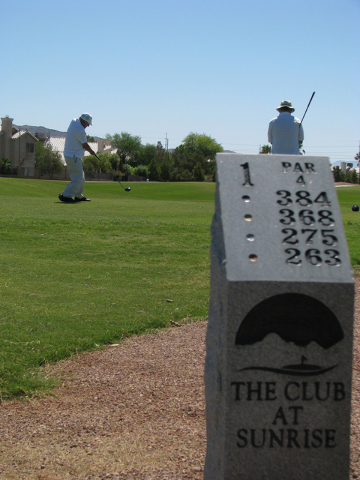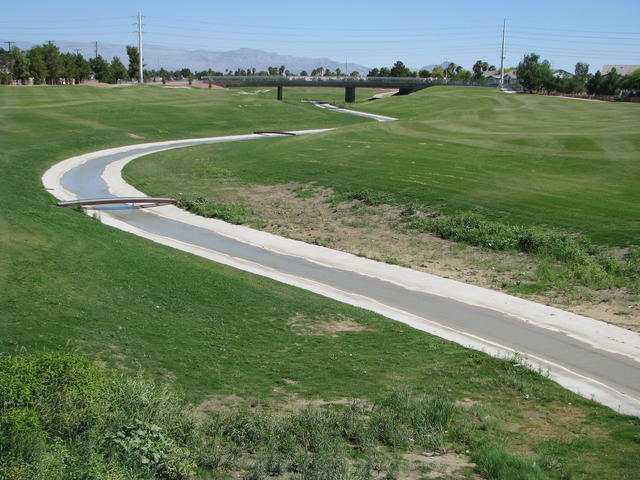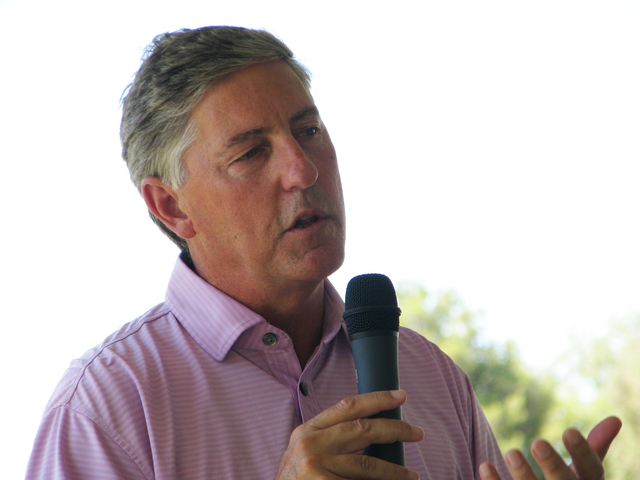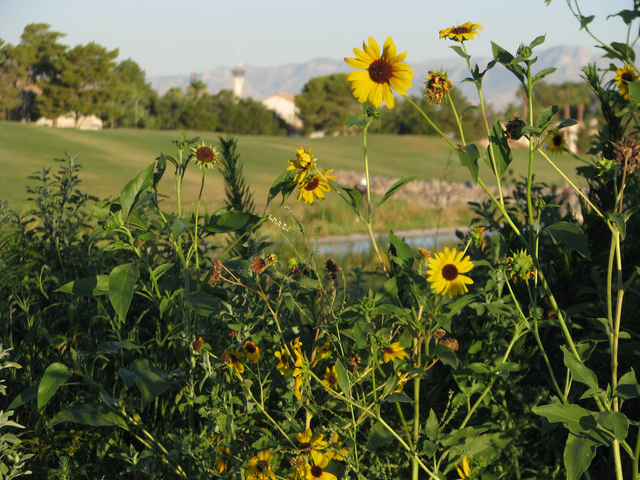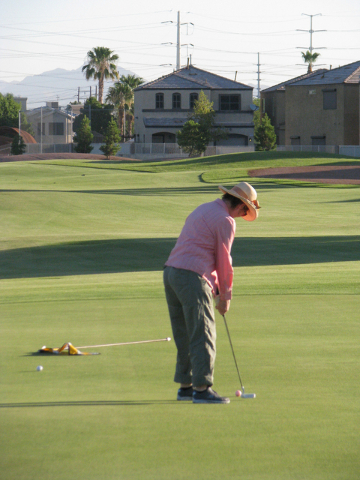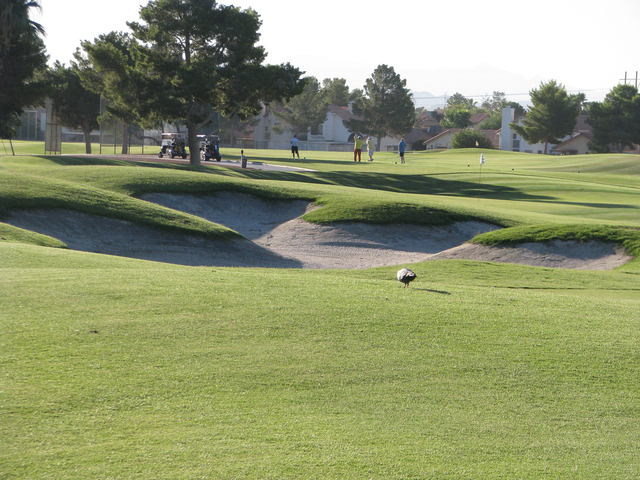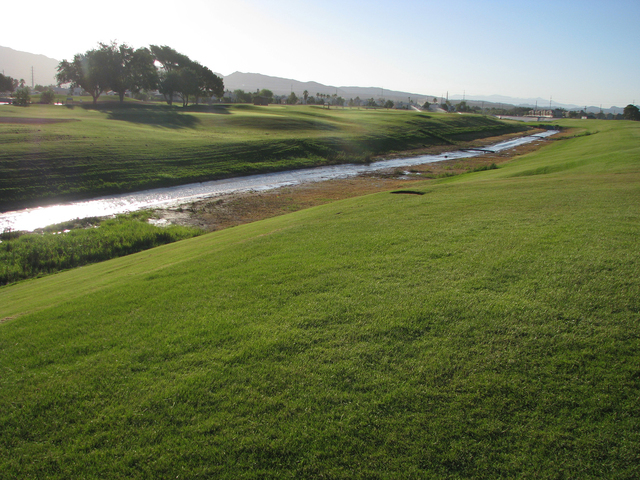Course redesign protects homes, offers east Las Vegas residents new golf experience
The golf course formerly known as Desert Rose Golf Course has reopened as The Club at Sunrise, and it appears to be a hit with golfers and residents alike. The course at 5483 Club House Drive was reopened with a tee off ceremony in which several Clark County officials and members of the stakeholders committee participated July 12.
The course, which includes the confluence of the Flamingo and Las Vegas washes, had been closed following a massive flood on Sept. 11, 2012, that damaged many of the houses around it, destroyed several course holes and left maintenance worker Luis Lopez-Solis dead. The renovation took several factors into consideration, including making the washes safer and able to contain flood waters while maintaining the natural green aspect of it. The stakeholders committee of concerned golfers and residents insisted that they did not want a concrete channel running through the course, so only a relatively narrow strip on the the bottom of the channel is concrete.
“The community not only gets a brand new golf course but also the people who live along the course are safer,” said District E County Commissioner Chris Giunchigliani. “The people who live there have the reassurance that they can sleep a little easier at night knowing the channels are here protecting them during storm events.”
Randy Heckenkemper, who redesigned the course, noted that it presented some unusual challenges, but that he was pleased with the final result.
“We had to design the course with an evacuation plan, which is something I’ve never had to do before,” Heckenkemper said. “The new course has a cart path that is completely above the 100-year flood line, so golfers can get out when floods come through. The only exception is when the path goes under the new Sahara (Avenue) bridge, so we put side trails up to the street there.”
The new bridge where Sahara passes over the course replaces an old bridge that was shorter in length and height. It had become a choke point for rising flood waters.
“We had to destroy the course, lower the channels up to 12 feet in some places and rebuild it,” Heckenkemper said. “The course would flood seven or eight times a year, and it would ruin golf holes and bury parts of the course in silt. We still get the same amount of water, silt and trash through here, but now we have it controlled so that it is only down the channel, where it’s away from the holes and easier to clean up.”
The course has weathered several flood events already, and the redesign performed exactly as it was supposed to. One interesting part of the redesign addresses one of the inconvenient aspects of the former design. Balls would often be struck over the wash, and there were only a few larger cart bridges crossing over. The new course includes many small foot bridges, allowing golfers to retrieve balls more easily.
“The bridges are built on a swivel,” Heckenkemper said. “They are attached on one corner by a bolt, so the flood waters will just push it aside instead of send it downstream. They can be pushed back in place with one of our pieces of equipment.”
Heckenkemper said the $64 million renovations and channel redesign will begin to be recouped in lower maintenance costs. He added that plans to redesign the course predated the flood, when the Federal Emergency Management Agency corrected some of its old flood zone maps, reclassifying 17,000 homes along the wash as in a flood zone.
The changes to the golf course have led FEMA to reevaluate the homes’ status, and Heckenkemper is confident 14,000 will be reclassified and out of the flood zone, meaning not only will flood insurance no longer be mandatory, but it will be less expensive.
“$1.4 million annually will be saved on insurance premiums just for this project,” Heckenkemper said.
Another cost-cutting measure was the installation of Platinum TE Seashore Paspalum, a turf that is hardier, uses less water and fertilizer and is suitable for use all over the course. The green and the rough are the same turf, cut to different lengths.
“It’s an unbelievable grass,” Heckenkemper said. “We are the most inland course to use wall-to-wall Platinum TE. It’s salt-tolerant, so we can use reclaimed, repurposed water. We’ve also reduced the acreage of the grass we use. We’ve switched to decomposed granite outside of the 100-year floodplain. Sustainability is not something we just say. We live it.”
One section of the course is bordered by a manufactured housing community, which had numerous breaches in the fence prior to the renovation. Giunchigliani said that the county received many complaints about racoons and coyotes coming off the golf course at night and attacking residents’ cats and dogs.
“Technically, the fence is their responsibility, but the contractor worked it in, and we’ve got new fencing that goes underground and keeps them from digging their way in,” Giunchigliani said. “It’s an improvement that will benefit the rest of the neighborhood if it inspires the people the fence protects to renovate their property.”
The course was also redesigned to make the houses bordering it less likely to be struck by errant golf balls. This was achieved by shifting tees and aiming the drives farther away from the surrounding structures.
“We wanted to make sure the houses along the course were no longer pockmarked with golf ball damage,” Giunchigliani said. “It’s worked to improve the surrounding homes. Since we’ve started this project, about a third of the homes in the area have been renovated. It seems to be making people care more about their neighborhood.”
The Club at Sunrise is the only golf course owned by the county, and it is open seven days a week. The newly renovated clubhouse is also open to the public.
Visit theclubatsunrise.com.
To reach East Valley View reporter F. Andrew Taylor, email ataylor@viewnews.com or call 702-380-4532.
The Club at Sunrise
Address: 5483 Club House Drive
The Club at Sunrise is the only golf course owned by the county, and it is open seven days a week. The newly renovated clubhouse is also open to the public.
Visit theclubatsunrise.com.





